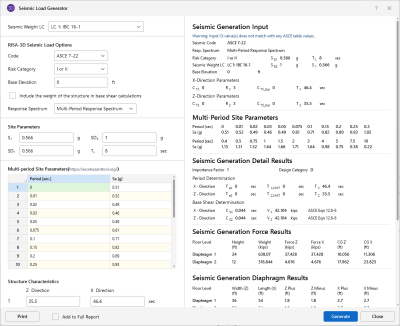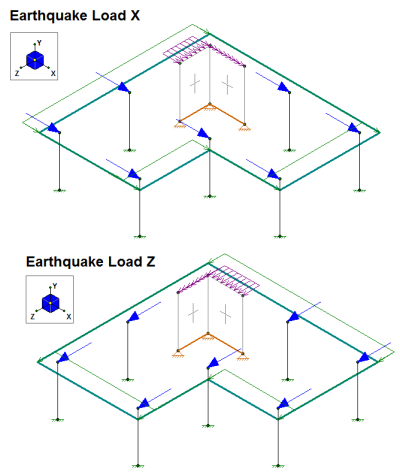Load Generation - Seismic Loads
Building Seismic Loads can be automatically generated according to the equivalent static methods of the following codes:
- ASCE 7-2022 / IBC 2024
- ASCE 7-2016 / IBC 2015 / IBC 2018
- ASCE 7-2010 / IBC 2012
- ASCE 7-2005 / IBC 2006 / IBC 2009
- ASCE 7-2002 / IBC 2003
- IBC 2000
- 1997 UBC
- 2001 CBC (California Amended UBC)
- Mexican NTC-04
- Indian IS 1893:02
- Canadian NBC-2015
- Canadian NBC-2010
- Canadian NBC-2005
Seismic load can only be applied at diaphragm/floor levels. The program automatically calculates the center of mass and the 5% accidental eccentricity for the various seismic load cases.
- The Seismic Loads generated by the program are calculated for Building Structures ONLY and may not apply to non-building structures.
- The Seismic Loads generated by the program consider accidental eccentric loading as well. If you plan on using the Load Combination Generator in the Load Combinations spreadsheet, you must use the "X and Z w/Eccentric" Seismic Load option. Otherwise the eccentric BLCs that have been generated will never actually be applied.
Seismic Weight
The Seismic Weight of each
While computing the seismic weight at a particular diaphragm, the self weight of the members/columns and plates between any two diaphragms is equally distributed amongst these diaphragms. Any weight, or load included in the specified load combination, supported between diaphragms is distributed to the diaphragm above and below in inverse proportion to its distance from each diaphragm.
The total seismic weight of the whole structure is the sum of the seismic weights associated with all  button in the Load Combinations spreadsheet.
button in the Load Combinations spreadsheet.
For additional advice on this topic, please see the RISA Tips & Tricks webpage at risa.com/post/support. Type in Search keywords: Diaphragms.
Seismic Design Parameters
The parameters used in the seismic calculations may be viewed or changed
Click on image to enlarge it
In RISA-3D, the weight used for the calculation of seismic loads is based solely upon the Load Combination specified as the Seismic Weight LC entered in the Seismic Loads Dialog shown below:
Click on image to enlarge it
For additional advice on this topic, please see the RISA Tips & Tricks webpage at risa.com/post/support. Type in Search keywords: Generate Seismic.
Seismic Load Parameters
Code currently allows you to choose the code to be used for seismic load generation. For reference, sections of the 2022 edition of ASCE 7 are cited to explain the various entries.
T represents the input natural periods in each lateral direction. These would typically be determined from an eigensolution analysis. If these values are not entered, then the program calculates this using the Approximate Fundamental Period as defined in section 12.8.2.1 of ASCE 7-22. This value is entered for each of the Global horizontal directions.
R is the Response Modification Factor as defined in table 12.2-1 of ASCE 7-22. It provides a reduction for the design seismic force based on the ductility of the system. This is defined for each of the Global horizontal directions.
Base Elevation determines the height at which the structure is assumed to be connected to the ground. This is important for hillside structures or structures with sub-grade floor levels. A certain amount of structure self weight may be associated with base level (or sub-grade levels) of the structure. The Add Base Weight check-box determines if that self weight will be added into the base shear to be distributed as lateral force through the height of the structure per section 12.8.3 of ASCE 7-22. If no elevation is chosen for base elevation, then the lowest joint in the structure is assumed to be the base elevation.
Risk Categoryis used to determine the importance factor assigned to the structure per table 1.5-2 of ASCE 7-22.
Response Spectrum allows the user to choose between a two-period response spectrum or a multi-period response spectrum. This option is only available when the code selected above is ASCE 7-22.
Seismic Weight LC is used to dictate which load combination should be used to define the weight of the structure when the seismic event is assumed to occur. In ASCE 7-22 this would be based on the criteria in section 12.7.2.
Seismic Load Results
When you activate RISA-3D via the Director menu, the program calculates the appropriate seismic loads and present the calculations in a printable report. You can open the seismic load generator at any time to view, print, or recalculate the seismic loads.
Seismic Generation Input
This section displays all the relevant design data entered so that it can be included on print outs with the Seismic Load results.
Seismic Generation Detail Results
This section reports the values used to obtain the Base Shear in each of the two global directions.
Importance Factor is determined from Table 1.5-2 of ASCE 7-22, based on the specified Risk Category.
Design Category is determined in Section 11.6 of the ASCE 7-22 and reported here.
V (Base Shear) is calculated using the Governing Equation listed next to it.
Governing Equation is the equation which was used to calculate the base shear. This is typically from 12.8 of ASCE 7-22.
Seismic Generation Force Results
This section displays information used in distributing the seismic force to each diaphragm or story level. This includes the calculated Height and Weight of each diaphragm, the calculated Force in each horizontal direction and the calculated location of the Center of Gravity of the diaphragm (CG).
Seismic Generation Diaphragm Results
This section displays information used in calculating the accidental torsion values. This includes the Width and Length of each diaphragm and the distance used for the accidental eccentricity.
- The magnitudes of the seismic loads are based on the settings under the Seismic tab of the Model Settings dialog.
- The Joints / Nodes used to apply seismic load may appear as a "diamond" shape pattern of unattached nodes at that diaphragm level. While these nodes may not be attached to any beams or framing, they are attached to the diaphragm at that floor level. To get rid of these nodes, it is necessary to re-run the Seismic force generation with the design code set to NONE.
- Any equations based on NON-building structures are not currently taken into account for the seismic load calculations.
Semi-Rigid Seismic Loads
When running a combined RISAFloor/RISA-3D model the program has the ability to create Semi-Rigid Seismic loads and apply them to the diaphragm. The seismic load is calculated by taking the Total Seismic Weight and converting it into a horizontal direction by multiplying by the seismic response coefficient Cs.
The program applies a Diaphragm Surface load which represents the seismic contribution of the Slab weight and any additional Dyn Load. There are horizontal point loads and line loads at the top of the columns and walls which represent their respective contribution of the seismic weight. Any point, line or area loads that are "Dyn Mass" is also converted as horizontal seismic load applied directly to the diaphragm. Below shows an example of the Earthquake loads applied into a simple L-shaped building.
Click on image to enlarge it
- For a RISA-3D only model you need to manually apply your loads and build your diaphragm with plates. See the Semi-Rigid Diaphragms section for more information on this.
- Any Openings in the slab (Concrete Floor Slabs) will have the self weight correctly accounted for.

